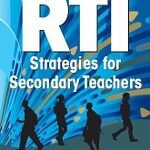Tier One

Given my experience teaching at the high school level as both a special education teacher and a co-teacher who worked within the inclusion model, as well as my experience coaching in middle schools and high schools around the country, I have become convinced that every secondary classroom needs to begin at Tier One: differentiating instruction so that all students can learn. When teachers differentiate instruction, 80-90% of students are successful in meeting achievement benchmarks. (Hanson 2009)
- The verbal linguistic, auditory delivery of information where students are expected to passively sit in their seats and take in information while trying to copy notes at rapid speed does not work for all students.
- The students it does not work for are the students who are not responding to education and are doing poorly in the classroom as well as on their state tests. While this method may work for some teachers and some students, it does not work for the majority of our struggling student population.
- A consequence of the lack of differentiation at the secondary level is that students who move on to college, whether to engineering coursework or technical school, primarily learned only one mode of studying. When they become college students and are met with challenging coursework, they often lack the study skills to support them in the more rigorous academic environment. This is why we often find that our most successful high school students don’t meet expectations at the college level.
The reality is that until we differentiate instruction at the secondary level, a basic requirement of Tier One RTI, we are shortchanging all our students: English-language learners, students with special needs, trade bound students, or students heading off to college.
Excerpted from RTI Strategies for Secondary Teachers by Susan Gingras Fitzell.

